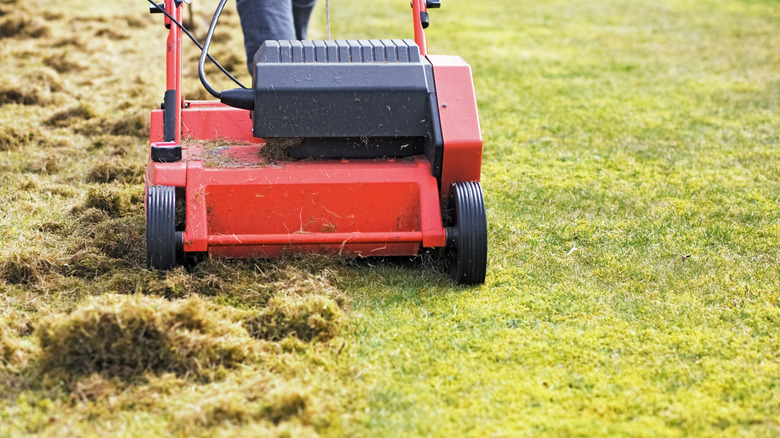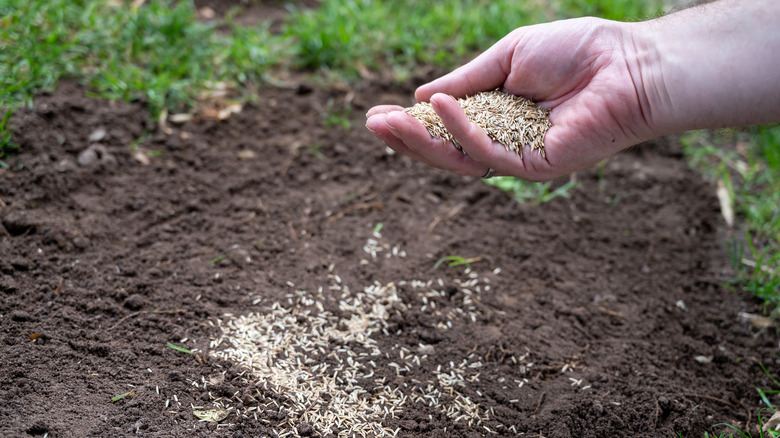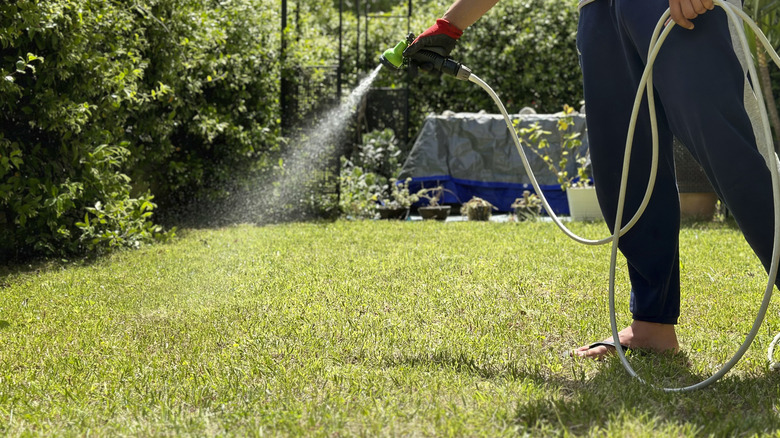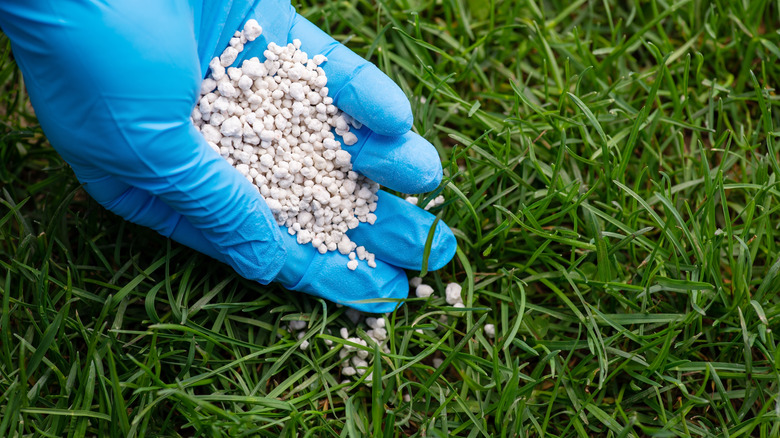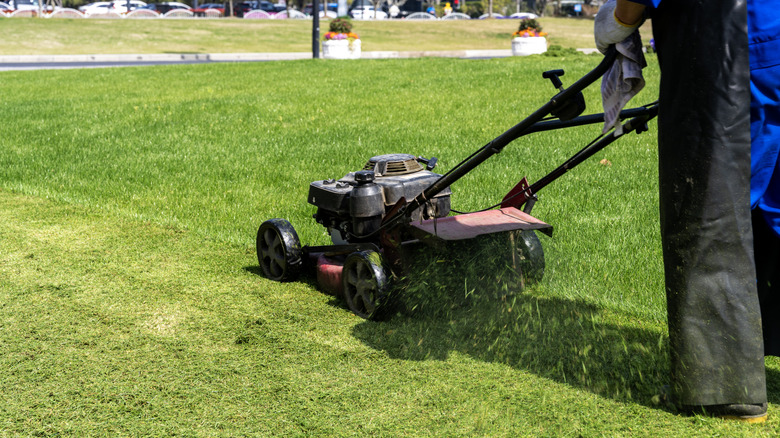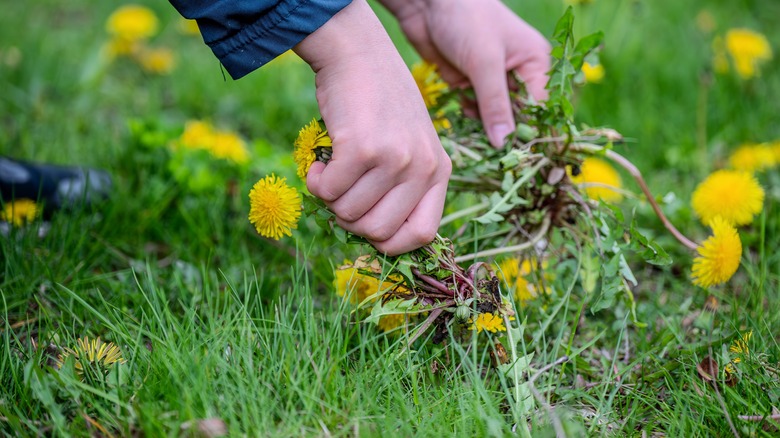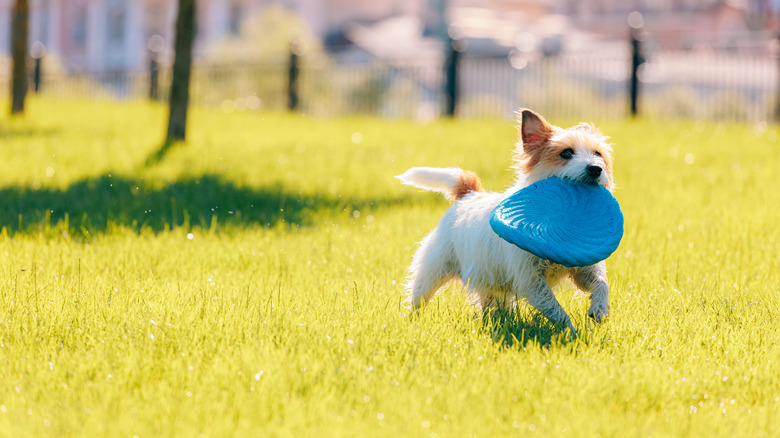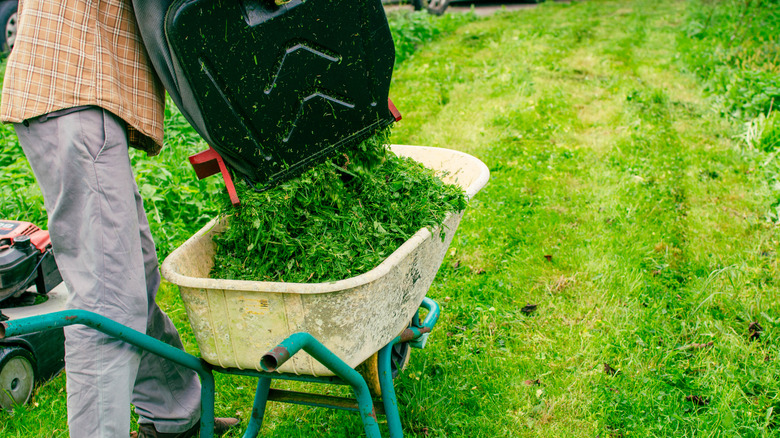12 Ways To Transform A Lackluster Lawn Into A Stunning Green Oasis
We may receive a commission on purchases made from links.
Are you on a mission to get your turf looking lush, pristine, and perfectly manicured — maybe even enough to make the neighbors slow down as they walk or drive past your curb? If you're starting with a lackluster, neglected lawn that's patchy, bumpy, brown, or (sigh!) weed-riddled, the task might feel pretty daunting. But by prioritizing lawn health and following these best practices, you can get that emerald green carpet of grass you're yearning for.
To help you whip your turf into immaculate shape, we've rounded up a dozen ways to transform a sad lawn into a stunning green oasis. Topdressing, dethatching, aeration, reseeding, and grasscycling are a few options. Your lawn will also benefit if you focus on its cultural requirements starting from the ground up, improving how you water, fertilize, and mow it throughout the year. Redressing pests, diseases, and weeds harboring in the turfgrass will also keep it in the best of health. Besides these long-game methods, we also share a low-effort hack for turning brown, dormant turfgrass instantly green.
Deal with thatch accumulation
If you don't dethatch your lawn for many years, it can eventually grow unsightly and feel squishy underfoot. Thatch — the springy, brown mat of dead tissue that accumulates between the green turf and the soil — prevents water and oxygen from making their way underground. This can force grass roots to grow sideways within the thatch layer, resulting in a shallow lawn vulnerable to drought and scalping. Worse, it can become a resting ground for Rhizoctonia solani, a fungus responsible for brown and large patch disease in cool- and warm-season lawns. Patch fungus typically presents as several discolored patches in spring and is typically bordered by orange or yellow grass blades.
To avoid these outcomes and restore your lawn's health and appearance, dethatch it when the layer grows over ½-inch thick. A thin layer is fine, as it insulates the grass roots from extreme temperature fluctuations and makes them more resilient against foot traffic. To check the level of buildup, remove several pie-shaped segments across the lawn and measure the brown layer (simply press the segments back down after checking). If it's more than half an inch, power rake the soil with a robust detacher, like LawnMaster's GVB1316 Electric model. If you're dealing with very thick thatch, a vertical mower might be the better choice. It'll slice down into the thatch, eradicating the spongy effect and allowing water and air to reach the soil. You can either hire a lawn service to do this, or invest in a two-in-one dethatcher (the above LawnMaster is one example) that has a scarifying blade attachment.
Aerate compacted areas to improve root health
Core aeration entails pulling out plugs from the turf and is the surest fix for soil compaction — one of the top enemies of a lush lawn. Foot, pet, and vehicle traffic can all compact the soil. Compaction is a particular issue in areas with heavy, clay soil and high rainfall. Once compacted, the soil will be hard, compressed, and lack drainage. During rainy periods, water might pool or run off, and the soil may struggle to dry out, increasing disease pressure. During drought, the ground might get so dry that it becomes very difficult to rehydrate. Compacted soils can result in a shallow root system, which makes lawns less resilient to drought. This can culminate in thin turf and bare patches of ground. Weed pressure may rise, too, and thatch can start accumulating because decomposing organisms, especially earthworms, feel suffocated in such conditions.
Fortunately, core aeration can turn a compacted lawn that's become patchy and thin back into a lush oasis. To remove compaction and restore root health, aim to aerate your lawn once a year, or twice if the ground is particularly heavy or receives a lot of traffic. The first step is to make sure you're buying or renting the right kind of aerator for your yard. While spike aerators can work in some situations, they aren't the solution for high levels of compaction. In fact, they can actually increase compaction. Instead, rent a core aerator that makes about 3-inch-deep holes. You may need to make over three passes (a properly aerated lawn has over 20 holes per square foot). Later, mow the area to break apart the soil plugs and spread them out evenly.
Topdress annually to improve soil quality and correct minor bumps
Good topsoil is paramount for a healthy lawn, and it should be at least 4 to 6 inches deep. If your turf has been planted on a very shallow layer of topsoil that doesn't contain much organic matter, it's going to be hard for you to get dense, healthy growth. You might encounter drainage issues (either too much or too little), the soil might not hold onto nutrients well, or be so compacted that the grass has a very hard time developing a deep root system and thick carpet of blades. Topdressing the turf can help build up a healthy layer of topsoil over time. Spreading a thin layer (between ¼ and ½ inch thick) of compost and topsoil on the grass will increase the organic matter content and improve the overall structure. This will increase water retention in sandy soils, and increase drainage in heavy soils. Another way topdressing is useful is when you've got a bumpy lawn or small, bare spots. With topdressing, you can even out the surface while simultaneously enhancing the soil quality and encouraging denser coverage.
Topdress annually in fall or early spring and aim for a mix of compost and topsoil that's similar to the existing soil. For instance, if you have a silty loam, then the soil you use for top dressing should be a silty loam. This will help prevent soil layering (layers of very dissimilar soil) that can impede even drainage. To speed up decomposition and absorption, mow the grass shorter than normal to enable better contact. A lawn leveling rake (like this Rocklin™ Lawn Leveling Rake) or rotating spreader like the Landzie Compost and Peat Moss Spreader Roller can make distributing the topdressing easier, but you can also use a regular rake.
Reseed bare patches
If your yard's looking patchy, reseeding is an easy fix to get it looking lush once more and prevent weeds from taking over. Either interseed using the same turf variety for a uniform look and improved density. Alternatively, overseed with a different variety to introduce a hardier version that can better withstand foot traffic or shade. This technique also comes in handy if you don't like the appearance of dormant grass and wish to overseed for a perpetually green lawn ('Fireball' ryegrass is one of the best dark grass varieties for overseeding in fall).
Generally, if your turfgrass is a spreading or creeping variety, like Kentucky bluegrass, St. Augustinegrass, or buffalograss, you can leave small patches alone. As the stolons or rhizomes spread, the grass will fill out the space during the growing season. However, if the bare spots are over 4 inches wide or you've got bunching grass types (think ryegrass and fescue), reseeding is the most economical way to refill exposed areas. You can hand-seed small areas. Simply mix seeds with fertilizer in a 1:4 ratio and drop as you go. For big areas, something like the Scotts Turf Builder Broadcast Spreader could be ideal.
Watering deeply, and not every day
Hot temperatures and drought stress can turn the best of lawns lackluster if your irrigation is not on point. This holds especially true for cool-season grasses, including Kentucky bluegrass, perennial ryegrass, and fine fescue, that tend to go dormant during extreme summer heat. Drought-stressed turf can wilt, droop, and shrivel, turn a bluish-gray color, and start to show footprints because the water-stressed blades aren't able to bounce back immediately. To prevent this, your first instinct might be to turn the sprinklers on for a few minutes every night. This is a mistake, as frequent, shallow watering can encourage shallower roots, which ultimately will make your turf even more vulnerable to drought stress.
Instead, you should aim to soak the whole root zone, which typically extends around 4 inches deep. This means applying roughly an inch of water when there hasn't been any rain. If your turf has dried out severely, you may need to apply a few rounds of light watering to rehydrate the soil gently (as one big watering may just run off instead of permeating the ground). But after this, you should be able to stick to weekly or bi-weekly watering, depending on your soil, the amount of rainfall, and how quickly the grass is losing water (hot, dry spells will speed up the evapotranspiration rate). You can use a soil moisture probe, like Dr.meter's Soil Moisture Meter, to gauge how moist the soil is down into the root zone.
Fertilize the right amount at key growth times
Fertilizing the right amount at the right time is key for an emerald green lawn. Under-fertilize, and your grass might not have the nutrients necessary to put out lush growth, and may become strawy or discolored. Weeds or insects may also overrun the turf, reducing it to a pitiable appearance. However, over-fertilizing your lawn can trigger scorching, with the severely hit spots growing dead and bare. Shoot growth can also outpace root growth, creating excessive thatch.
Start with a soil test — either through your local state extension or with a home kit, like Luster Leaf's Rapitest Soil Test Kit. Select a slow-release fertilizer tailored to your grass type, sun exposure, and soil. To prevent damage, time fertilizer applications with when the turf is actively growing. Feeding warm-season grasses in late fall or winter (during dormancy) can induce cold injury — so fertilize in late spring. Fertilize cool-season grasses in the late autumn and spring when their roots are growing vigorously. If you maintain a high-density lawn, you may need supplementary application in early summer.
Mow high, with sharp equipment
Mowing correctly is not just a matter of pride; it also impacts your lawn's health. Regular mowing encourages fresh growth and density. However, if you mow too low, the grass won't have the necessary food to survive and will eventually thin out, resulting in bare spots that are vulnerable to weed invasion. Mowing too low can also cause scalping. What does it mean to scalp your lawn and why is it bad? Scalping happens when you cut down into the stems, instead of just trimming a portion of the grass blades, leaving the turf looking stubbly, brown, and exposed.
High mowing, on the other hand, promotes deeper root penetration and mass, enhancing the turf's resilience to grubs and droughts. The soil retains moisture for longer, which is valuable in hot, dry climates. Taller grass blades can also shade out germinating weeds (bye-bye crabgrass).
So, how high should you mow? Tall fescue can be cut at the highest setting on your mower (which is generally 4 inches), whereas species like fine fescue and Kentucky bluegrass can be cut a little lower at 2.5 to 3.5 inches to prevent the blades from flopping. Also, you shouldn't remove more than ⅓ of the grass blade in one session. Bonus tip: Be sure to sharpen the blades after every 10 mowing hours. Dull blades create ragged cuts with brown edges, which not only look unsightly but can be entry points for disease.
Keep on top of weeding
Let's face it: Unless you maintain a legion of staff, you can't have a lawn that's 100% weed-free. But weeds overrunning a lawn can result in bare patches once they are frost-killed. This holds especially true for summer annuals, like crabgrass, spotted spurge, and knotweed. With perennial grassy weeds, too, such as quackgrass, nimblewill, and wild fescue, you can expect bare patches when the foliage dies back during winter. By staying on top of weeding, you can keep these unsightly bare patches to a minimum.
Hand pulling is one of the least harmful ways to kill weeds in your lawn and can even work for tough species such as dallisgrass, especially during establishment. But for hard-to-uproot invaders in your lawn like nutsedge, you might have to turn to herbicides. To treat annual weeds like crabgrass, you can apply a pre-emergent herbicide in the bare patches so the seedlings are killed before they produce seeds. Herbicidal soaps can be effective on small weeds that have already germinated. For nutsedge, you'll need to pick your product and application times wisely (Sedgehammer Turf Herbicide is one of the few effective options available for home use), and pair herbicide applications with a regimen of other nutsedge-killing tips.
Minimize pet spots by watering or training
Did you know your dog could be to blame for your grass turning yellow? When dogs squat to pee, this releases a large amount of nitrogen and salts through the urine into a small area of ground. The nitrogen stimulates grass growth around the margins of the 3- to 6-inch wide urine spot, often appearing taller and greener than the surrounding area. In the center of the patch, the salts desiccate the grass, rendering the blades strawy, yellow, or tan, and making the turf look uneven and patchy.
If pet spots are an issue, you can try training your dog to go elsewhere, perhaps at the lawn's periphery where the damage won't be as noticeable. Alternatively, establish a dedicated mulched bed, which they can mark to their heart's pleasure. Alternatively, be prepared to stay at the ready with a hose and wash down the area when your dogs are done with their business. Urine spot damage can usually repair itself if the turf is a spreading variety. However, reseeding or resodding may be necessary for clumping grasses like fescue.
Retain grass clippings after mowing
If you're aiming for a pristine, lush lawn, you might assume that all clippings need to be bagged up and removed. However, this could actually rob your turf of a valuable source of nitrogen. If you remove the clippings, you also remove the nutrients, including nitrogen, that you've fed the turf over time. But if you retain the lawn clippings (aka grasscycling), as opposed to bagging and carting them off to the landfill, you can actually reduce your turf's fertilization requirements by 30% or even 50%. Clippings are also a source of organic matter, which can improve soil structure and, with that, overall lawn health. So while strewn clippings mightn't have been part of your original game plan for creating a lush oasis they definitely aren't something to be aggressively raked, bagged, and hauled away.
However, there are a few caveats. First, make sure you aren't removing more than ⅓ of the grass blade at a time. Otherwise, the clippings will be too long and may smother the grass and cause thatch buildup. Also, avoid retaining grass clippings if you mowed the lawn while it was wet, as they can mat and clump together and are harder to break down. You might also want to avoid recycling clippings from a diseased lawn to avoid further spread.
Apply liquid colorants for greener grass
This technique may come across as a short fix, but using a liquid colorant can be a gateway to greener grass. It's used by turf managers as an alternative to overseeding dormant warm-season grasses so golf courses and athletic fields still look aesthetically pleasing during winter. Colorants don't harm turf health, are inexpensive, and they can also be utilized in residential lawns.
If you don't find dormant grass pleasing, something like EnviroColor's 4Evergreen Grass & Turf Paint can net you instantaneous results. Or, if you're entertaining guests and your turf has some blemishes or diseased spots that need masking, use this liquid colorant for a neat look. Liquid colorants work for both cool-season and warm-season grasses. They may even help grass grow faster in cool conditions by increasing the temperature at the surface level.
If you simply can't wrap your head around "painting" your lawn, you can also experiment with liquid formulations containing iron for warm-season turf. An iron boost can turn the grass greener than it already is and can last anywhere between a fortnight and a month. Some fertilizers (like Scotts Green Max Lawn Food) contain iron for added greenness, and you can also get liquid iron, like Southern Ag's Chelated Liquid Iron.
Keep a close watch for chinch bugs
If you want your yard to mimic a green oasis, watch out for these tiny invaders. Chinch bugs can leave lawns marred with yellow and brown areas that look as unsightly as they are bad for your turf. Cinch bugs can become a particular issue if you don't irrigate or have fast-draining sandy soil. When spring temperatures exceed 50 degrees Fahrenheit, adults emerge from their overwintering sites and mate, producing hundreds of eggs. Their damage becomes apparent during July and August, when the adult bugs are most active. They sap grass stems of fluids and infect them with a toxin, which turns the turf yellow. Over time, the yellow changes to russet brown, and the affected areas die completely. Because this happens during the dog days of summer, the damage can be misdiagnosed as drought stress.
If you spot yellow grass, part the thatch layer and scan for any tiny, black bugs crawling around. You may also find them loitering about walkways or driveways when it's sunny. Alternatively, push a 1-gallon metal can with its top and bottom removed and fill it with water to see if any cinch bugs float up. To remove the infestation, affected areas can be spot-treated with pyrethroid insecticides, but these can harm beneficial insects that are natural controls for cinch bugs, so overuse can actually make cinch bug problems worse over time. Going forward, keep watering and maintain tall grass in the summer. You can also try overseeding with endophyte-enhanced turfgrass, available for fescues and ryegrass, as they contain a beneficial fungus that destroys chinch bugs.

